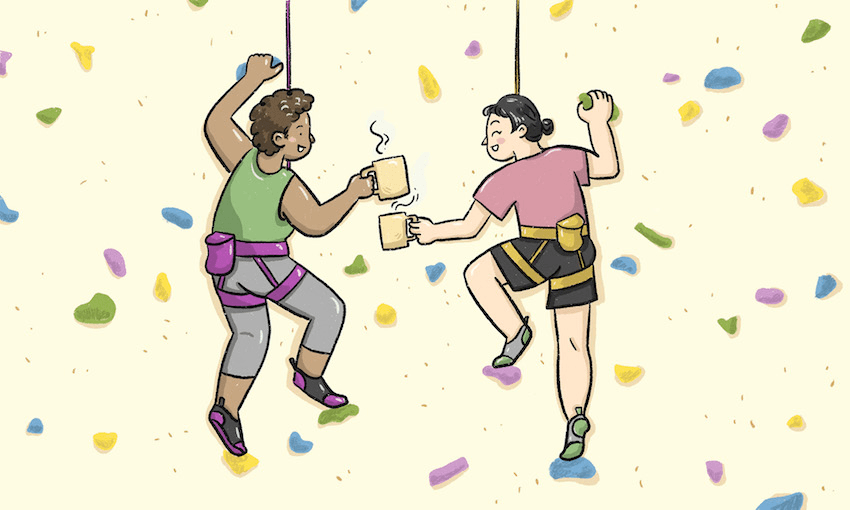Summer read: One woman finds solace and friends on the side of a cliff.
First published on February 20, 2022, as part of The Sunday Essay series made possible thanks to the support of Creative New Zealand.
Original illustrations by Kim Anderson
I started rock climbing shortly after my 30th birthday, and I swear to god, everyone I know is rock climbing now. Apparently there’s a phenomenon whereby you buy a car and then start noticing that model of car everywhere. I haven’t owned a car for almost 10 years, but every time I go on social media, I see that yet another friend has discovered bouldering. When I share a photo of myself on the crag, a different friend confesses in my DMs to loving ropes and belay devices. It’s been 18 months since I started rock climbing and all the people around me are rock climbers, or potential rock climbers.
Generally speaking, rock climbing comes in two main forms. One is bouldering: low climbs of under six metres that can be done safely without a rope. What bouldering lacks in height it makes up for in difficulty. Bouldering can take the climber upside down, weight hanging from the nails of their toes, performing simian movements as they match hands to feet. The other type of climbing is on routes too high to fall safely from, and so is typically done with a rope, unless you’re Alex Honnold and you can climb all of El Capitan’s 884 metres without a single bit of protection. But for regular people with functioning amygdalae, a rope is a necessary piece of equipment when scaling walls.
Indoor bouldering is a relatively modern invention and the type of rock climbing that I do most often. Bouldering gyms are basically Lollipops Playland, but for adults. The gyms feature white walls adorned with shapes in bright, rainbow colours. Climbers lounge on the thick mats under the walls, generating clouds of BO and chalk. The sound system plays bands like the Arctic Monkeys, LCD Soundsystem and Modest Mouse, a reminder that people my age are in low-level management now. I’ve climbed at most of the bouldering gyms around the country, and like Westfield malls, they all look and feel the same.
As with many physical activities, it’s hard to explain the appeal of climbing without experiencing it. There’s the way that it affords razor-like focus. Your field of vision shrinks, the din of the music fades away, it’s just you and the five to 15 plastic holds that make up the route. There’s the social element, where people of all sizes and abilities chat and support each other’s climbing efforts. There’s the addictive, game-like quality of the activity: there are different levels (grades), maps (crags) and items to carry in your inventory (outdoor climbing gear). You are the main player, and it’s up to you to increase your stats in strength, endurance and flexibility.
Climbing produces an evangelical fervour in its practitioners, especially if they’ve recently picked up the habit. I heard the good word at a dinner party, where a friend proselytised to everyone there about his new-found love for climbing. He delivered his message with such passion and enthusiasm that we all decided to give it a go. His timing for inducting new climbers could not have been more impeccable: it was June of 2020 and everyone was recovering from the first lockdown and thirsty for new things to do. Within two months our friend group had transitioned into a climbing group. A group chat called “Social Climbers” was started. Jargon like “flash”, “sent” and “sandbagged” started appearing in our parlance with each other. We all became obsessed with the motion of climbing up a wall, over and over again.
People my age often lament that it is hard to make friends as an adult, to which my reply is, “Have you considered going rock climbing?” I started climbing because my friends were doing it, but I’ve made so many new friends as a result. It’s true that new adult friendships are hard to build, and sadly often deprioritised in favour of romantic relationships. After leaving the repetitive confines of education, it’s hard to get that regular, passive social contact that is a requirement for friendship. But hanging out at the rock-climbing gym provides that environment in adulthood. Chit-chat comes easily when you’ve got a bouldering problem in front of you to seed a conversation, and slowly the small asides that people give about their lives build into a more complete picture of their life in and out of the climbing gym.
Through this shared love of climbing, I now have a lot of activity-based relationships in my life. When I was younger I didn’t understand, and perhaps judged, people who had these types of relationships. At the time, my relationships with people were mostly feelings-based, in which we would drink coffee and analyse at length what was going on in our lives. The intensity of these exchanges imbued the moments with meaning, and I felt like people who just came together to play ping pong or whatever weren’t really friends. How could batting a ball around compare to baring your hearts to each other? What can you learn about someone by doing an activity together?
In outdoor climbing, one person climbs up the route and the one person stays on the ground and manages the tension in the rope that keeps the climber safe. One of the major differences between indoor and outdoor climbing is the distances you can potentially fall, and the safety of taking those falls. Going outdoor climbing is like that trust exercise where you fall backwards into the arms of your friends, except the fall might be uncontrolled and you might smack into something on the way down.
I started climbing outdoors with the same group of dinner party friends. None of us had any experience climbing outdoors. Outside of the safe and sanitised experience of gym climbing, people’s personalities had much stronger sways. We were all climbing up the wall, but some of us were taking more up with us than others. Watching a friend attempt an outdoor route, I could read all their strengths and weaknesses in the way that they approached the climb. The friend that I knew to be more comfortable with risk climbed fearlessly, climbing with a drive to get to the top rather than climbing to prevent falling. The more anxious friend needed constant communication while they were climbing. The intensity of the activity brought to the fore emotional responses that were more easily controlled when nerves weren’t frayed. Climbing outdoors exposed a rawness I hadn’t seen much of in my friends in a while, a rawness that I hadn’t felt myself since I got older and by and large learned to manage my feelings.
Outdoor climbing introduced a schism in the friend group, as it left some feeling uncomfortable with the level of risk. Unlike gym climbing, all the safety precautions and knowledge (or lack thereof) had to come from our gaggle of beginners. After a while only two of us remained enthusiastic about climbing outdoors, the two of us that were dubbed the most “risky” by the rest of the friend group.
Perhaps this stems from my apparent daredevilness, but I personally don’t think outdoor climbing is that dangerous. It’s not so much about risk taking, but rather risk management. Really, the trait that I thought connected us two remaining outdoor climbers was our propensity to become completely submerged by an obsession. Indoor climbing is pure physical joy. But outdoor climbing requires technical knowledge about esoteric topics like knots, anchors and rope management. For some this introduces a tedious level of detail, but for me this type of complexity has always made my brain fizz in a particular way. I enjoy the Rube-Goldberg nature of outdoor climbing, the satisfaction of having completed every step to perfection, and most of all, the inconsequentialness of it all. Getting up that wall is a completely personal achievement, and there is nothing to be gained or lost by other people from me being able to complete a climb.
On climbing trips I lie in my tent at night, hands still throbbing, and in my mind’s eye is an image of a rock wall. There are chalky pockets, and the faint smudges of rubber-soled shoes. Quotidian worries have dropped away. There is a peace that comes from not being able to think about anything else. Being able to cultivate an adult hobby is a precious experience. They are the new substitute for dogs, the previous generation’s substitute for children unavailable to this generation of renters. They are a source of meaning, a way of keeping the everyday from feeling mundane, an avenue of insight into yourself and the people around you. I’m sorry that I am an active relaxer and my chosen obsession is rock climbing. I hope you all have something meaningful in its pointlessness to do.

